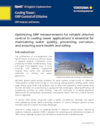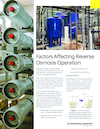What Is a Liquid Analyzer?Liquid pH ORP analyzers and conductivity analysers are used for monitoring process chemistry including water quality, providing process optimization and control. Common measurements include pH, ORP, conductivity, resistivity, percent concentration, and dissolved oxygen. What Are the Industrial Applications of Liquid Analyzers?
What Is Conductivity in Water Treatment?In water treatment, water must pass a conductivity test to see if it passes an electrical current. Conductivity in water is related to inorganic solids, including ions carrying a negative charge (chloride, nitrate, sulfate, phosphate anions) and ions carrying a positive charge (sodium, magnesium, calcium, iron, aluminum cations). The conductivity level of water is also dependent on temperature. What Are the Benefits of Liquid Analyzers?Liquid analysis is essential for protecting critical and essential assets including boilers and cooling towers, by preventing corrosion, minimizing maintenance, and maximizing uptime. Yokogawa is a recognized world leader for reliable liquid analytical equipment, providing accurate and repeatable solutions for maintaining and controlling even the most demanding process optimization and control applications with unparalleled ease of operation. |
 Use our Liquid Analyzer Sensor Wiring Guide to easily find the correct wiring for your liquid analyzer sensor. |
-
SENCOM™ SMART Digital Sensors
Reduce configuration time and simplify maintenance
-
pH and ORP Analyzers
Optimize field maintenance, calibration, and system configuration
-
pH and ORP Sensors
Ensure fluid process operations
-
Conductivity Analyzers
Maintain and control even the most demanding process applications
-
Conductivity Sensors
Measure aqueous solutions quickly and reliably
-
Dissolved Oxygen Analyzers
Built to withstand the harshest applications
-
Product Finder
This web tool makes it easier to find products according to the application, measurement conditions and required specifications.
Recursos
Suministro de Tratamiento de Agua
FAST/TOOLS, STARDOM, Medidores de Flujo, Analizadores de Líquido
- La Planta de tratamiento de aguas de Bali decidió utilizar la última versión confiable del sistema de control con el fin de incrementar la disponibilidad y la calidad de la operación.
- Sistema de Control Centralizado que utiliza FAST/TOOLS provee una operación sofisticada y flexible.
Problems at the wet end of a paper machine can rarely be corrected downstream. That is why monitoring and controlling pH in pulp stock is critical to the paper-making process. Essentially, at every stage in the manufacture of paper, correct pH values play a vital role. Variations in the pH value at the headbox have a negative effect on the quality of the paper produced. Proper monitoring ensures minimizing plugging and fouling problems that occur with pH measurements in paper mills.
Optimizing ORP measurements for reliable chlorine control in cooling tower applications is essential for maintaining water quality, preventing corrosion, and ensuring work health and safety.
Dairy wastewater is a mixture of organic compounds, suspended solids, fats, and bacteria that can produce a film or coating on equipment in the process.
Yokogawa’s Process Liquid Analyzers series help pigment producers achieve a more reliable and accurate analysis of pH during industrial bioprocesses, improving product quality with less total operation costs.
How integrating advanced pH sensors with temperature compensation, chemical resistance, and a dynamic mounting system can prevent fouling and damage.
Are you trying to decide how to tackle that next challenging application? Join our Back to Basics webinar series as we review the fundamentals behind different measurement technologies. We will discuss recommended practices, application selection, and sizing, and how to avoid common pitfalls. Gain insight directly from our experts!
Documentos y Descargas
Catálogos
- Liquid Analyzer Sensors and Fittings (5.9 MB)
- Liquid Analyzers in the Water Industry
- Process Analyzers Analytical Instruments and Systems Overview
- Product Solution Catalog Applications (2.8 MB)
- FLXA402 4-Wire Liquid Analyzer, SA11 SENCOM Smart Adapter (2.9 MB)
- Electrolysis Solutions: Instrumentation Solutions for Electrolysis Plant Applications (841 KB)
- SENSTATION (492 KB)
Manuales
- Model FF20 Flow fittings Model FS20 Subassembly flow fittings Model FD20 immersion fitting (3.4 MB)
- Model FU24F pH/ORP SENCOMR sensor (1.3 MB)
- Model PH202SJ [Style: S2] 2-wire pH/ORP Transmitter (293 KB)
- Electrodes - Instructions for placing colour code marks (87 KB)
- ISC202SJ [Style: S1] 2-wire Inductive Conductivity Transmitter with Supplement (371 KB)
- SC202SJ [Style: S2] 2-wire Transmitter for Conductivity or Resistivity with Supplement (1.3 MB)
- SS400G MLSS Converter (3.7 MB)
- PH8USF ULTRASONIC OSCILLATOR (Explosionproof Type) and PH8AL ALARM BOX (889 KB)
Especificaciones Generales
Información Técnica
- pH/ORP Analyzer Selection Guide (726 KB)
- FLXA202/FLXA21 2-Wire Analyzer HART Communication (1.8 MB)
- FLEXA/EXA PH Series Process pH Meters Basic and Products (1.2 MB)
- Cation Differential Quick Start Guide (1.4 MB)
- Conductivity Analyzer Guide (992 KB)
- Process Liquid Analyzer Sensor Wiring Guide
- Boiler Life Cycle Considerations
- pH and ORP Learning Handbook (7.5 MB)
Videos
SENCOM- The Next Generation in SMART Liquid Analyzers
Yokogawa’s SENCOM SMART Sensor Platform is an innovative analyzer platform that optimizes maintenance, reduces configuration time, and simplifies in-field maintenance and calibration. Yokogawa is a recognized world leader for reliable liquid analytical equipment, providing accurate and repeatable solutions for maintaining and controlling even the most demanding process applications.
Noticias
-
Nota de Prensa mar 26, 2012 Yokogawa Releases New 2-Wire Transmitter FLXA21®
¿En busca de información adicional sobre Yokogawa Iberia, tecnología y soluciones?
Contáctenos








